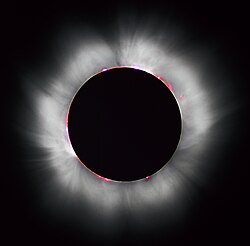
Back Sonsverduistering Afrikaans Sonnenfinsternis ALS የፀሐይ ግርዶሽ Amharic Eclix solar AN كسوف الشمس Arabic كوسوف ARY সূৰ্য গ্ৰহণ Assamese Eclís solar AST Günəş tutulması Azerbaijani گونش توتولماسی AZB

As seen from earth, a solar eclipse /ee-klips/ happens when the moon is directly between the earth and the sun. This makes the moon fully or partially (partly) cover the sun. Solar eclipses can only happen during a new moon. Every year there are about two solar eclipses. Sometimes there are even five solar eclipses in a year. However, only two of these can be total solar eclipses,[1][2] and often a year will pass without a total eclipse.
The area in which an eclipse is total is only a narrow track along the earth. Totality lasts only a few minutes. Outside this path, all eclipses are partial, and places far from the track get no eclipse at all. The track can be predicted many years before it happens.
A total solar eclipse is a natural phenomenon (event). Long ago, solar eclipses were thought to happen because of something supernatural or as a sign that something bad was going to happen. This is still believed in some cultures today. A total solar eclipse can frighten people who do not know what it means, because the sun seems to disappear during the day and the sky turns dark in just a few minutes. Other people like to go to the eclipse path for a good view while wearing special glasses.
Solar eclipses happen somewhere on earth almost every year, and very similar solar eclipses happen every 18 years, 11.3 days. This period is called the Saros cycle.
- ↑ Littmann, Mark; Fred Espenak, Ken Willcox (2008). Totality: Eclipses of the Sun. Oxford University Press. pp. 18–19. ISBN 978-0199532094.
- ↑ Five solar eclipses occurred in 1935. NASA (6 September 2009). "Five Millennium Catalog of Solar Eclipses". NASA Eclipse Web Site. Fred Espenak, Project and Website Manager. Retrieved 26 January 2010.